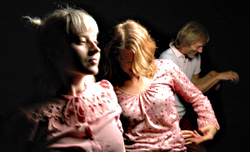It seems appropriate to have a conversation with Dayna Hanson on All Saints Day about her upcoming performances at On the Boards, since the subject of her newest work is death. We Never Like Talking About the End is the first piece Hanson is presenting since she and her former collaborator, Gaelen Hanson, formally dissolved their company 33 Fainting Spells, but she maintains the same idiosyncratic style, combining dance with theater, performance art, film, writing, and anything else that comes to her mind. But having closed up 33 FS, it’s no surprise that she’s starting this new stage in her creative life with a work about endings.
The genesis of We Never Like Talking links to a series of interviews on the paranormal Hanson compiled for her 2005 solo Spirit Under the Influence, in which her subjects touched on near-death experiences. Intrigued by their stories, Hanson took a closer look at the time when, as she puts it, “the body has died but the soul hasn’t figured it out yet.” The world her subjects describe—an “incredibly pleasant” place where they aren’t allowed to remain—and the transformations in the lives that they are called back to complete, are the core of We Never Like Talking. Hanson structures the work around these video interviews, setting the other components among them, like a mosaic artist using intact bits of individual colors rather than trying to mix or blend them. “[It’s like] putting elements together and letting them talk to each other. I don’t know how the elements will relate, I operate on hunches and impulse.”
Hanson’s first training was as a writer, and she describes the making of We Never Like Talking as “writing a play,” but it’s a work with many collaborators. In addition to her interview subjects, she asked musicians Dave Proscia and Maggie Brown for a score and invited visual designer Etta Lillenthal to organize a stage environment that includes space for technology as well as for human movement.
Alongside these living contributors, Hanson is drawing on another of her interests, the work of the late director John Cassavetes, incorporating dialogue and situations from his films into her script. “He loved humanity so much and he brought it to the screen. His love for people exceeded concerns for craft.” Hanson shares Cassavetes’ preference for emotional truth over technical clarity: “I don’t need flawlessness or perfection. [He] was willing to be a fool—to go to a place of embarrassment to get to great truth.”
In rehearsal, the movement reveals Hanson’s quixotic signature style. Impulses jump from place to place in the body, rather than spinning out in long, flowy sequences. The complexity is in the relationships between body parts, which move in a fairly restricted space instead of charging across the stage. Highly gestural, looking almost like a personal version of sign language, the rhythmic structure is unusual, with accents shifting away from the standard downbeat. Seen with the music, they create a kind of postmodern counterpoint.
Later in the rehearsal, Hanson’s father, Vern, arrives. He’s appeared on video in Hanson’s previous work, and she’s pleased that he’s able to perform live with her in this project. A skilled t’ai chi practitioner, he starts moving through a form. He is joined by Ezra Dickinson, one of the other dancers, who seems to be following along: his focus is clearly on Vern, his timing lags just a bit behind. It’s a gentle reminder of standard dance practice, in which students learn by imitating their teachers, and a lovely example of one generation passing knowledge on to the rest of us.








